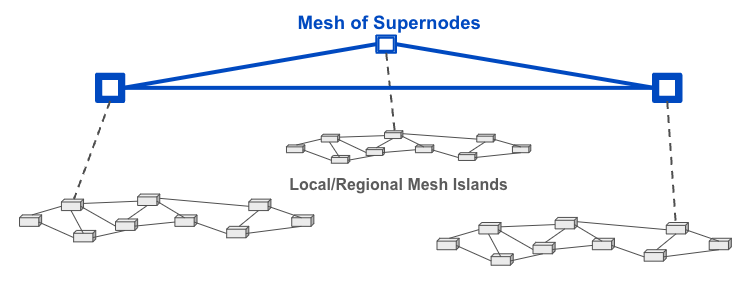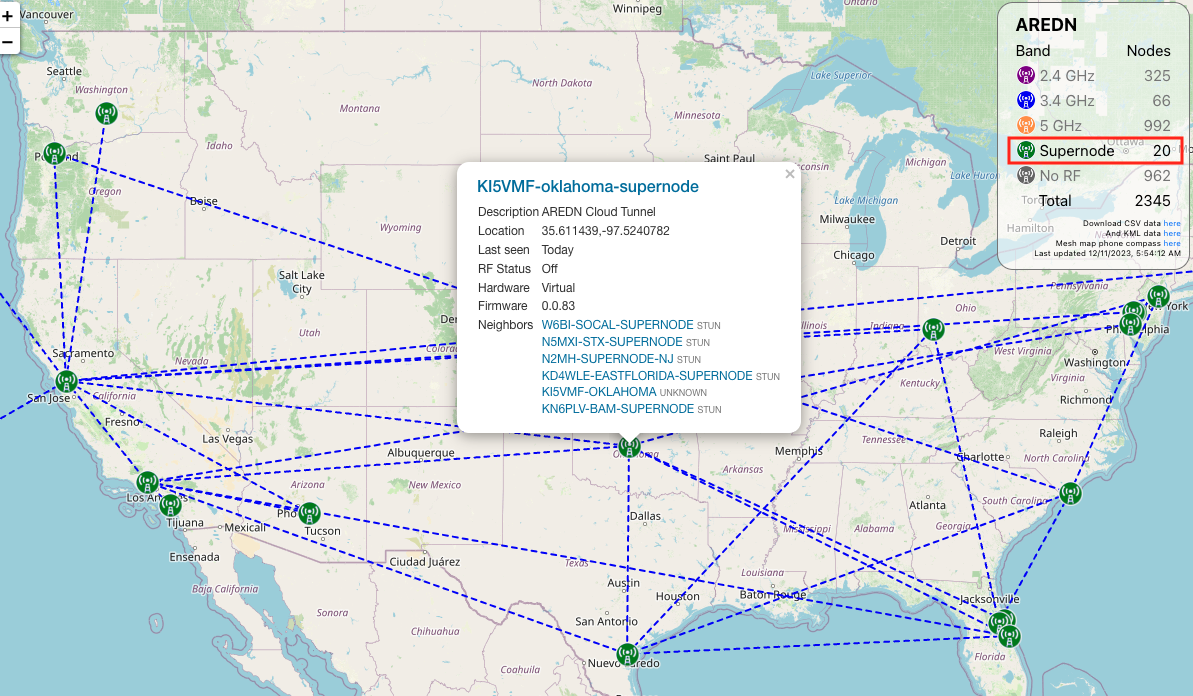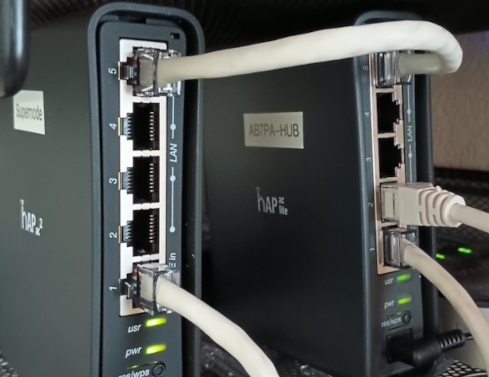Configuring a Supernode
Supernodes are a way to link multiple mesh island networks in a safe and efficient way. A Supernode network is a high-level mesh network — super meaning “above or higher.” The Supernode network sits above the isolated mesh networks and provides connectivity without increasing the routing load on the local networks. Supernodes do not merge networks into one big mesh but instead isolate connections between discrete meshes. For further information see the Supernode Architecture section of the Network Topologies topic in the Network Design Guide.

Criteria for Deploying a Supernode
Before you consider deploying a Supernode, make sure you can adequately support the level of uptime that is desired for the Cloud Mesh network.
Fast unlimited Internet connection. Fiber is preferable. Low latency between Supernodes is important as is available bandwidth. A Supernode can easily transfer 1 teraByte of data every month, so an unmetered connection is best.
Uptime stability. The Supernode should be up 99.999% of the time. The location should ideally have backup power and network connectivity, both to the Internet and to the local mesh.
Solid local mesh connectivity. As this is the path for all traffic between your local mesh and every other mesh, the connection to your mesh should be at a high-bandwidth location. If you are deploying a Supernode with any sort of high-bandwidth backbone, the Supernode should be connected to the backbone.
Coordinating Supernode Deployments
Because Supernodes use the OLSR (Optimized Link State Routing) protocol, multiple Supernodes can be connected to each other, each operating as a peer of the others. A local network can be connected to multiple Supernodes, but a single Supernode should only be connected to a single local network, although it may be connected at multiple points.
By having only a single local network connected to each Supernode, the owners of each local network are responsible for their own Supernodes. This simplifies management and maintenance. There is also some fault isolation as a failed Supernode will only affect the link to one local network.
The number of messages a Supernode receives will scale linearly with the total number of nodes in all connected local networks. A Supernode receives a management message from every node in the network (all nodes in all local networks) every 5 seconds. With a typical message size of 100 bytes, a Supernode receives about 20 bytes per second per node. At the time of initial testing, there were 4,300 AREDN® nodes registered world-wide, so a Supernode for this network would receive 84 KB/s or 0.7 Mb/s, which is a manageable bandwidth requirement.
As more Supernodes are deployed linking more local networks, the overall performance of the Cloud Mesh will be impacted. Therefore, it is a good idea to coordinate the deployment of Supernodes among the Supernode owners at the time when tunnel links are requested for the Cloud Mesh.

Setting up a Supernode
Typically a Supernode is configured on a dedicated Mikrotik hAP ac2. Its sole task is to serve as a node on the Supernode network. The local sub-mesh network is linked to the Supernode using a DtD link on one of its LAN ports which is configured for dtdlink on the Advanced Network display (Port 5 by default).

The following steps are required to configure a Supernode.
Start with a Mikrotik hAP ac2 device that is newly flashed with the latest Nightly Build (≥ 20230930). If the node has been previously configured or used beforehand, please reflash and start fresh in order to avoid problems later in the setup process.
Configure the Supernode with a nodename prefixed with your callsign followed by a location identifier as well as the word “SUPERNODE.” For example you could use
AB2CD-NYC-SUPERNODEorAB6CD-LAX-SUPERNODEEnsure that Mesh RF is
disabledProvide a reserved or static IP address for the device’s WAN connection to your Internet routing device.
Do not add any other configuration settings at this point or you may encounter problems later in this process. At this point simply Save Changes and Reboot the device.
Login to the rebooted device via ssh or telnet to get a command line prompt, and then manually type and execute each of these commands:
# uci -c /etc/config.mesh add aredn supernode # uci -c /etc/config.mesh set aredn.@supernode[0].enable=1 # uci -c /etc/config.mesh commit aredn # /usr/local/bin/node-setup -a mesh # reboot
Your node should now be functioning as a Supernode. To validate this you can do the following:
Login to the Supernode vi ssh or telnet and type the following command:
cat /etc/config/aredn
Toward the end of the file which will be shown on the screen you should find the following lines:
config supernode option enable '1'
If somehow you do not see these lines, please start this process again from the beginning and make sure to follow every step in the sequence.
- Things to Avoid
Here are several things NOT to do when configuring your Supernode.
Your Supernode must not use any Cross-links (Xlinks) to other nodes
Your Supernode must not have tunnel links to any non-Supernode devices
Your Supernode must not have its Mesh RF interface
enabled– Mesh RF must bedisabledas noted above
Before proceeding, make sure all the previous steps have been completed successfully. Now you should be able to connect to another Supernode using a tunnel. The easiest way to do this is to ask another Supernode owner for a set of tunnel client credentials. Your node can use either a client or server tunnel link. Supernode tunnels use port 5526 rather than the usual tunnel port of 5525. Supernode owners can be identified from the Supernode Network Map